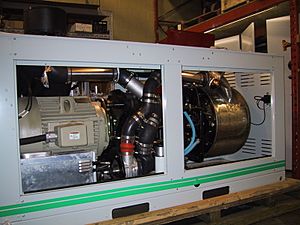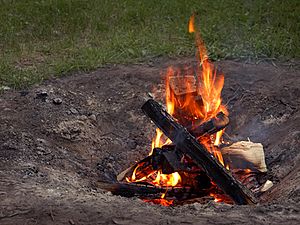Bioenergy facts for kids

Bioenergy is renewable energy made available from materials derived from biological sources. In its most narrow sense it is a synonym to biofuel, which is fuel derived from biological sources. In its broader sense it includes biomass, the biological material used as a biofuel, as well as the social, economic, scientific and technical fields associated with using biological sources for energy. This is a common misconception, as bioenergy is the energy extracted from the biomass, as the biomass is the fuel and the bioenergy is the energy contained in the fuel.
Biomass is any organic material which has stored sunlight in the form of chemical energy. As a fuel it may include wood, wood waste, straw, manure, sugar cane, and many other byproducts from a variety of agricultural processes.
There is a slight tendency for the word bioenergy to be favoured in Europe compared with biofuel in North America.
Solid Biomass
Biomass is material derived from recently living organisms, which includes plants, animals and their byproducts. Manure, garden waste and crop residues are all sources of biomass. It is a renewable energy source based on the carbon cycle, unlike other natural resources such as petroleum, coal, and nuclear fuels.

Animal waste is a persistent and unavoidable pollutant produced primarily by the animals housed in industrial-sized farms.
There are also agricultural products being grown for biofuel production. These include corn, switchgrass, and soybeans, primarily in the United States; rapeseed, wheat and sugar beet primarily in Europe; sugar cane in Brazil; palm oil and miscanthus in Southeast Asia; sorghum and cassava in China; and jatropha in India. Hemp has also been proven to work as a biofuel. Biodegradable outputs from industry, agriculture, forestry and households can be used for biofuel production, using e.g. anaerobic digestion to produce biogas, gasification to produce syngas or by direct combustion. Examples of biodegradable wastes include straw, timber, manure, rice husks, sewage, and food waste. The use of biomass fuels can therefore contribute to waste management as well as fuel security and help to prevent or slow down climate change, although alone they are not a comprehensive solution to these problems.
Images for kids
-
System boundaries for carbon accounting: Option 1 (black) limits the carbon calculation to stack emissions, option 2 (green) limits the calculation to the forest carbon stock, option 3 (blue) limits the calculation to forest and stack emissions combined (the supply chain) and option 4 (red ) includes both stack emissions, forest and the bioeconomy (carbon storage in wood products and displaced fossil fuels.)
-
Net emissions from various biofuel pathways (heat production). Stippled lines show net emissions for EU coal, light fuel oil, most relevant fossil fuel alternative, and natural gas. Dotted areas show emission savings percentages compared to the most relevant fossil fuel alternative (white 70–80%, green 80–85%, blue 85–100%.
-
Net emissions from various biofuel pathways (electricity production). Stippled lines show net emissions for EU coal (black), most relevant fossil fuel alternative (green), electricity mix (red) and natural gas (blue). Dotted areas show emission savings percentages compared to the most relevant fossil fuel alternative (white 70–80%, green 80–85%, blue 85–100%.
See also
 In Spanish: Bioenergía para niños
In Spanish: Bioenergía para niños














